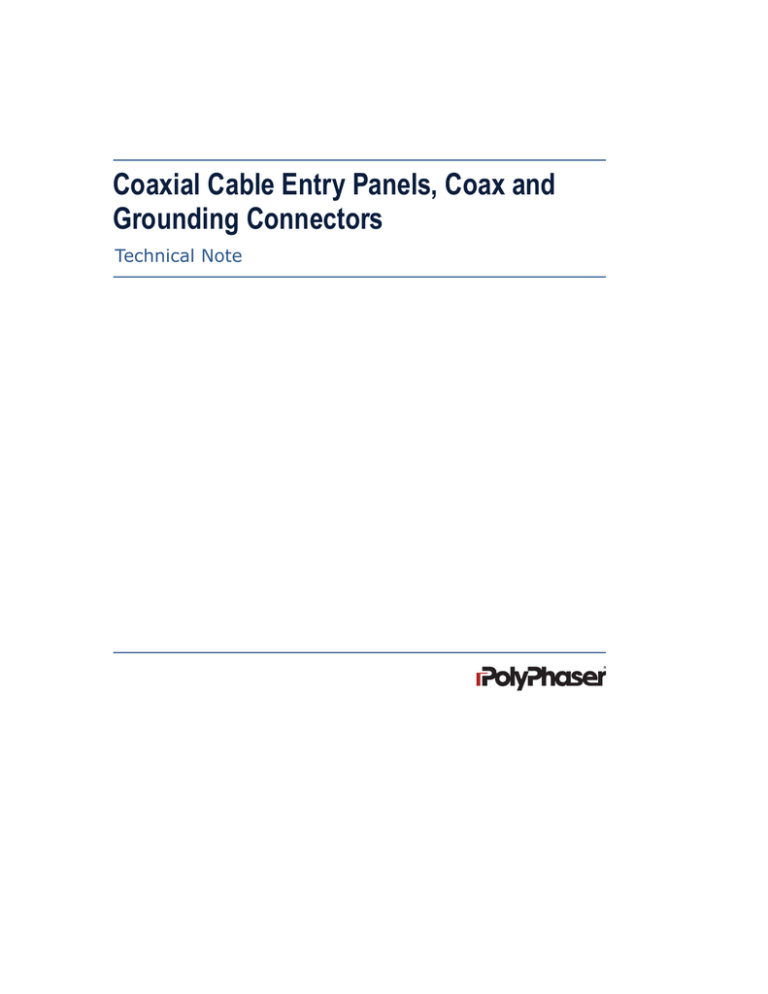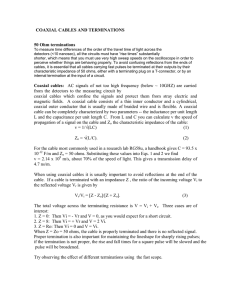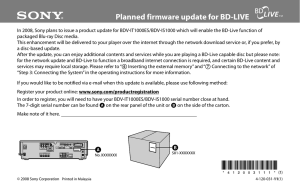Coaxial Cable Entry Panels, Coax and Grounding
advertisement

Coaxial Cable Entry Panels, Coax and Grounding Connectors Technical Note Coaxial Cable Entry Panels, Coax and Grounding Connectors | Surge Protection Solutions for PTC Coaxial Cable Entry Panels, Coax and Grounding Connectors Any input or output (I/O) line can carry surge current that can harm equipment. Of the primary I/O lines (power, phone, and coax), the coax cable(s) from the tower can bring in more surge current to equipment than any other source. The large surface area of the shield, the correspondingly low inductance of the coax, and the proximity of the coax to the tower present the fast rise time lightning current pulse with an ideal path towards the equipment. When struck by lightning, the tower acts like a voltage divider. For a few nanoseconds, there will be a high peak voltage at the top referenced to zero voltage at the base. Current will then flow through the tower and all attached conductors. The rise time and amount of current directed toward the equipment will be determined by the strike characteristics, how high the coaxial cable shields are grounded to the tower before they turn towards a building, the inductance of the tower with coaxial cables, the series inductance of the coaxial cables turning to enter the building/cabinet, and the parallel inductance of the building / cabinet entry conductors to ground. If the bottom coaxial cable ground kit (where the coax leaves the tower) is at any elevation above the earth, the inductance of the tower section between that ground kit and the earth is sufficient to cause a substantial voltage drop. The resultant voltage on the coax shield will drive current to the equipment where the electrical safety ground provides a path to ground. Once the surge is inside the building and on the equipment chassis, it is almost too late to try to protect the equipment. 2 3 Part -2 Length and shape of grounding conductors The best way to prevent such coaxial currents from reaching your equipment is to keep them from entering the equipment building. This may be accomplished by installing, on the outside of the building, a panel connected to the ground system with large surface copper strap(s). The large surface area strap is necessary to provide a low inductance path to ground for the surge energy as well as provide for the high frequency component of the strike energy. Each coaxial line as it enters the building is attached to the panel with an additional ground kit before connecting to a protector. The “BEST” way means to keep the coaxial cable run as low as possible while considering terrain and weather environment. A PolyPhaser bulkhead or PEEP entrance panel provides all of the necessary attributes required above. The bulkhead panel has a weather protected built-in grounding kit that will handle a wide range of coax lines. The low inductance ground connection is provided by multiple 6 inch [152.4 mm] wide copper straps attached with a sandwich bar to the 0.125 inch [3.2 mm] thick solid half-hard copper bulkhead. The panel is designed to mount/ground a PolyPhaser coaxial protector facilitating cable installation. Please note the below grade interconnection of the bulkhead panel with the other elements which comprise the grounding system. PolyPhaser Bulkhead rear view 1485-003 Coaxial Cable Entry Panels, Coax and Grounding Connectors | Surge Protection Solutions for PTC PEEP Entrance Panel side view 16 Port PEEP on Equipment Shelter Bulkhead PEEP Coax and protector grounding 4 5 Ground Conductors have lower inductance per unit length with larger circumference (Skin Effect) Solid Bond Copper Strap is best for a Grounding Conductor Connect coaxial cable shield ground kits directly to the tower, not to a single downconductor. Do not use isolated / insulated tower mounted copper ground bars. A tower mounted copper ground bar is acceptable if it is spaced from The building / cabinet entry ground conductor(s) should have approximately the same amount of circumference as the combined circumferences of all coaxial cable shields. For example, two 7/8 inch [22.2 mm] coax cable shields have a combined circumference / surface area of 5½ inches [139.6 m]. One 3 inch [76.2 mm] wide solid copper strap (6 inches [152.4 mm] circumference) should be run from a ground bar next to the coaxial cables directly connected to the earth ground system. The cable shields would be connected to the ground bar. Since a lightning pulse has a fast rise time, most of the electron flow will be on the surface of the conductor (Skin Effect). The straps in the above example would have at least the same amount of circumference as the combined circumferences of all the attached cables. The “circumference theory” is just that. Much of the information on this page is meant to inform and should not 1485-003 Coaxial Cable Entry Panels, Coax and Grounding Connectors | Surge Protection Solutions for PTC be interpreted as a “standard”. External cable trays or ice bridges should not be in contact with both the tower and the single point ground as they would direct more current flow towards the entry panel. The entry panel grounding conductors would be forced to carry additional current with an increased voltage drop appearing across the equipment racks. Isolate and support the cable tray at the building end. Only the coaxial cables and essential tower light wiring should complete the circuit. Grounding the ice bridge supports is recommended as long as the grounding conductors are bonded below grade to the earth ground system. The coaxial cables conduct a large amount of energy from the place on the tower where they turn towards the building. This is to be expected since coax cables are large surface area conductors. The more coaxial cable shield energy we can direct to earth ground through low inductance conductors outside of the building the less there will be inside the building to damage the equipment. This low inductance ground connection can be utilized as a single ground attachment point for the entire site. A master ground bar (MGB) together with an equipotential inside ground bar has been used successfully for years. When it is installed with properly rated lightning protectors, can provide “acceptable” levels of lightning protection.* Equipment side Tower Side * Lightning is a “natural world event” with varying parameters. What is “acceptable” risk is like buying insurance, the cost of protection goes up as the risk is reduced. 6


